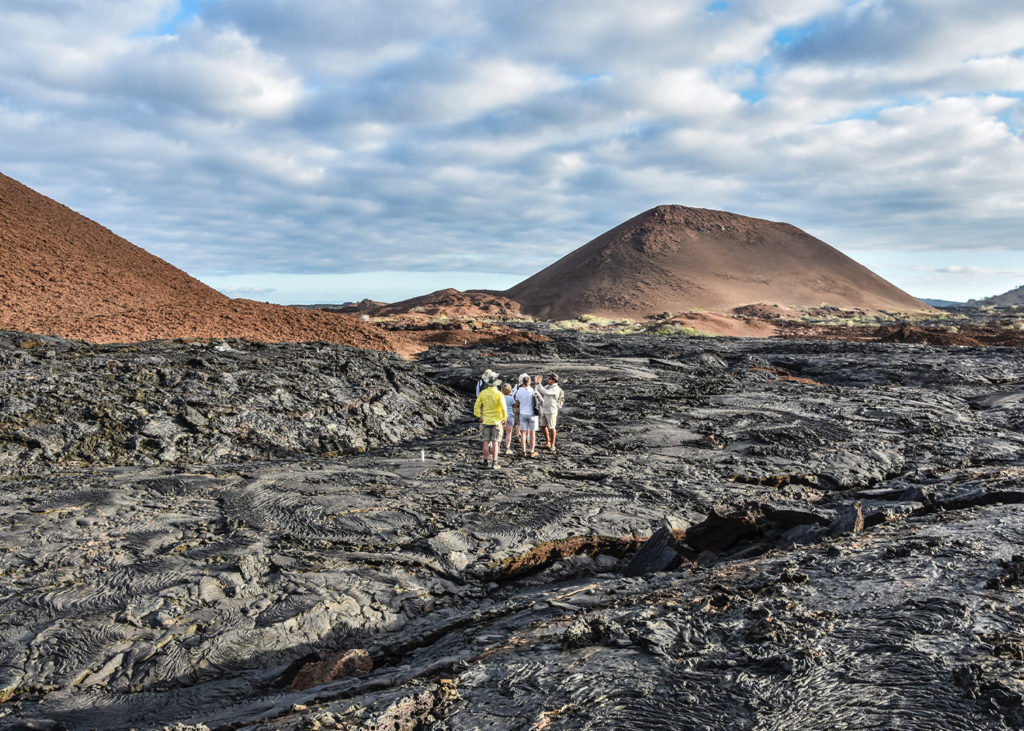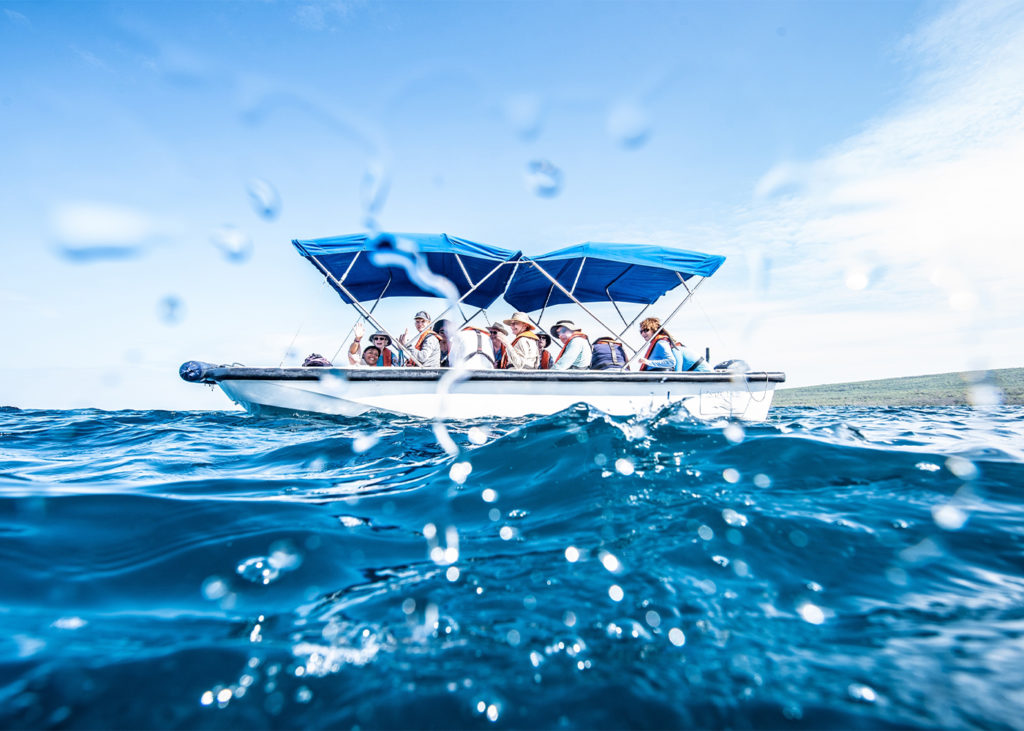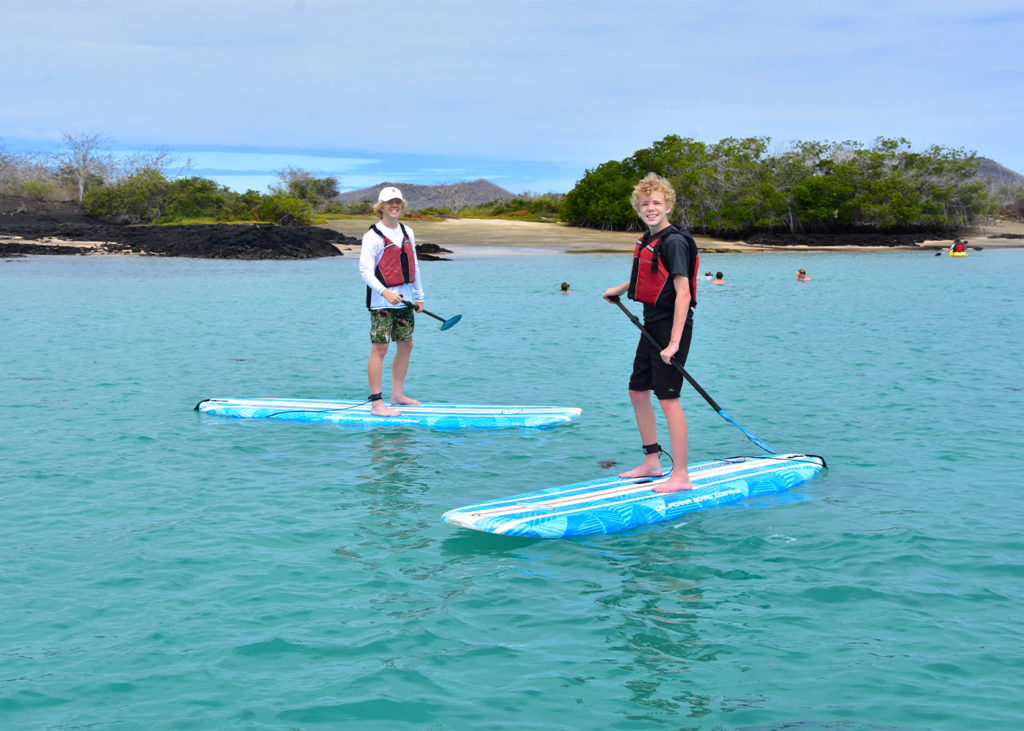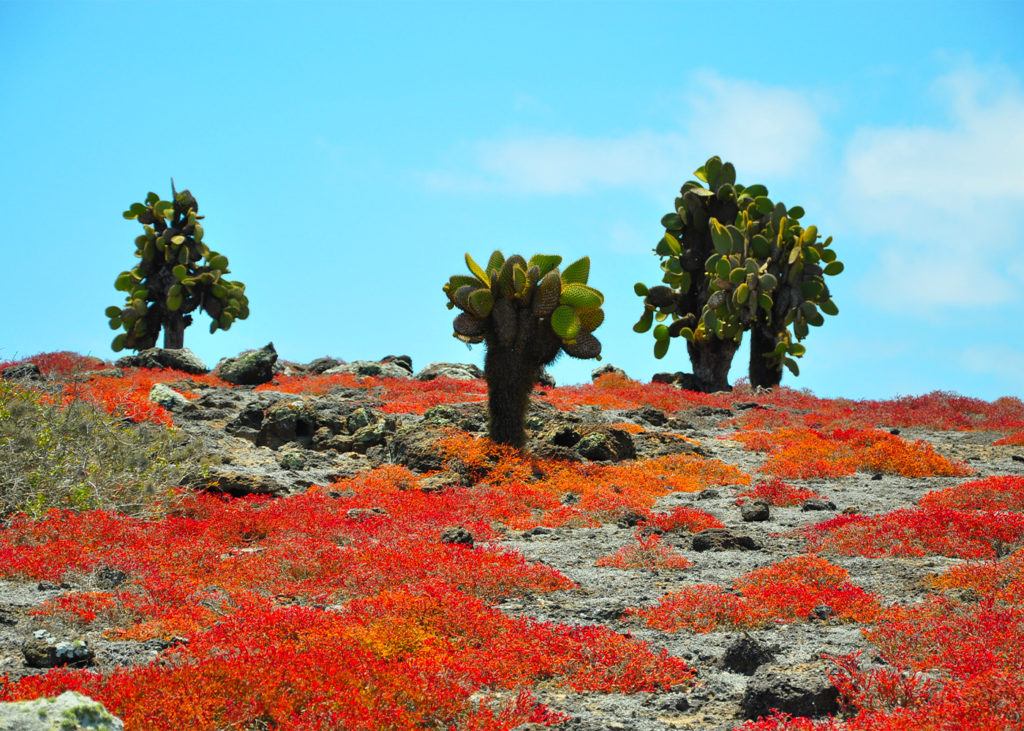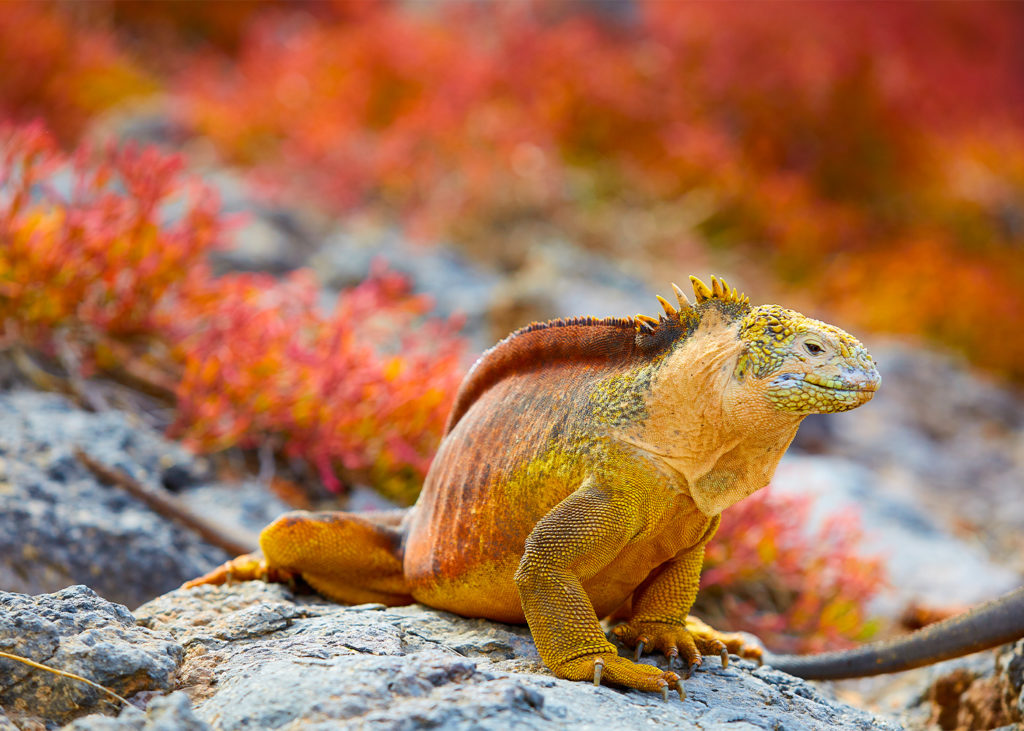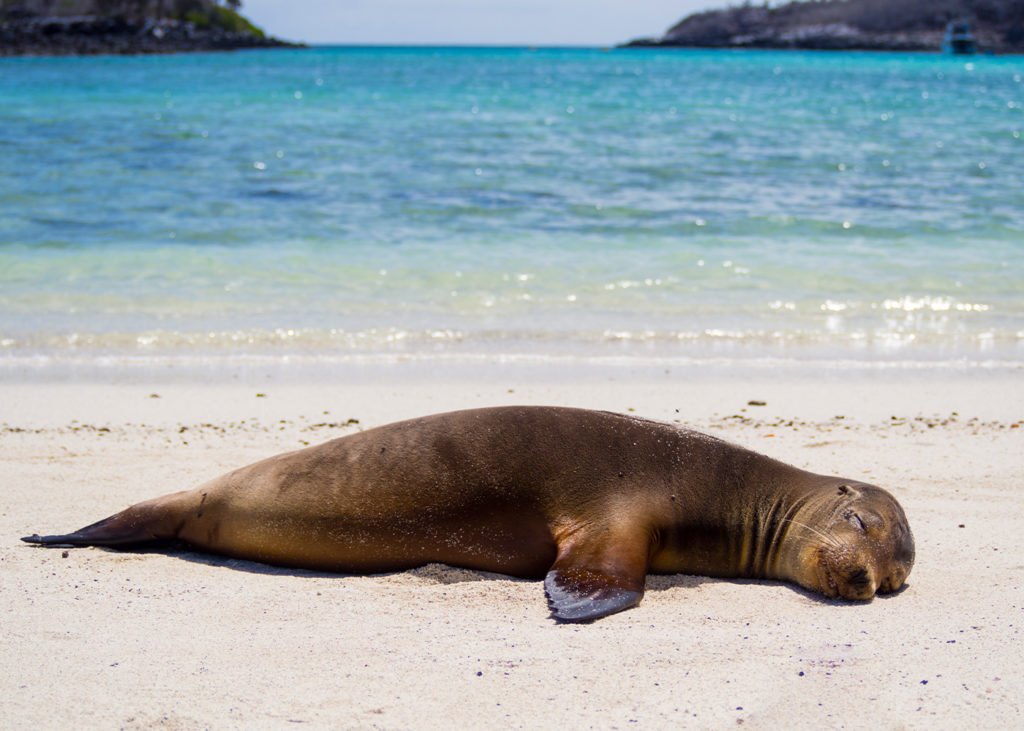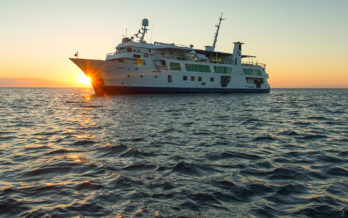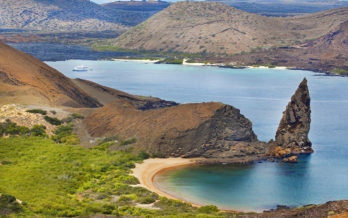Cruise Overview
Yacht La Pinta can accommodate up to 48 guests. Its ample social areas, observation deck towards the bow, wrap-around windows, hot tub, cardio-gym, kayaks, glass-bottom boat, sun deck, and sun loungers make it the ideal space for travelers looking for a sophisticated, upscale experience of the islands.
Her exciting itineraries promise a complete immersion in this exceptional environment. Thanks to our expert naturalist guides, you’ll get enriching wildlife encounters like few others on the planet. Spotless service, delicious cuisine, and stylish design will complement your experience on the islands. Thestaff embraces a spirit of adventure while ensuring safety and comfort at all times.
Yacht La Pinta has 24 comfortable cabins, all of them can be converted from twin to queen sizes, and four connecting cabins, all with full private facilities, permanent hot and cold water, sufficient closet space and central control panel for room temperature, public announcements system, individual MP3 sound system, volume and reading lights; all cabins are fully carpeted and air-conditioned throughout.
La Pinta is considered an ideal yacht for families traveling together, with many connecting cabins.
Cabin Types
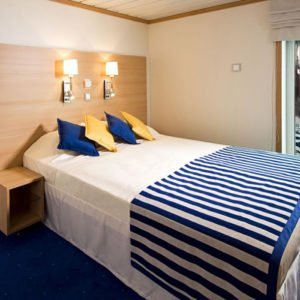
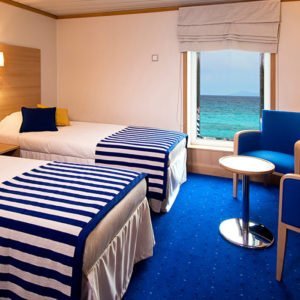
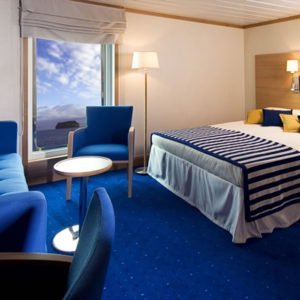
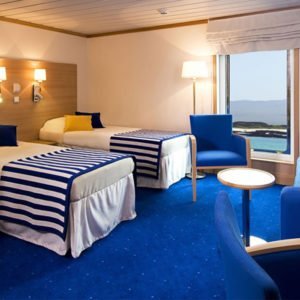
Western Islands
Departs Fridays
7 Days / 6 nights
Baltra Island. Morning arrival to Baltra Island and immediate transfer to the dock to board Yacht La Pinta. Welcome introductory briefing and lunch.
Afternoon Excursion
Afternoon disembarkation (dry landing) for a walk along the coast and the interior of the island, observing bird colonies of blue footed boobies, frigate birds, swallow tailed gulls and also sea lions and marine iguanas. Opportunity for snorkeling or coastal exploration. Evening briefing, welcome cocktail and dinner.
Morning Excursion: Punta Vicente Roca (Isabela Island)
Since there is no landing site at this location, the coastal exploration is by dinghy, while the naturalist guide explains the dramatic geology of the area with remains of lava flows and tuff stone layers. This is the nesting place for flightless cormorants, the only existing marine birds in the world other than penguins that have changed their condition of flying birds to diving birds. Wildlife here also includes sea lions, Galápagos fur seals, Galápagos penguins, blue-footed and Nazca boobies and noddy terns. Depending on the conditions of the ocean, it will be possible to schedule a snorkelling outing along the cliffs of partly-sunken Ecuador Volcano, near the northern tip of Isabela Island. This area has a very rich marine life, and is seasonally visited by green sea turtles. Lunch on board.
Afternoon Excursion: Punta Espinoza (Fernandina Island)
Afternoon visit to the youngest island of the archipelago, Fernandina. Disembark (dry landing) for a one-mile walk over dark lava. Punta Espinoza has an amazing combination of barrenness and a lot of wildlife. Having no introduced mammals, Fernandina boasts a very unique environment with the highest density of marine iguanas, sharing their space with sea lions, sally-light foot crabs, hawks, penguins and the flightless cormorant. Snorkelling is possible. Evening briefing and dinner.
Morning Excursion: Urbina Bay (Isabela Island)
After breakfast (wet landing) disembark at Urbina Bay, located at the foot of volcanoes Alcedo and Darwin, west of Isabela Island, the result of an uplifting of the ocean in 1954. Here you can find corals, shells, and many other calcareous organisms exposed above water. This area is also home to large and very colourful Galápagos land iguanas, giant tortoises (occasionally); a good spot to observe Darwin’s finches. Along the shoreline, after the hike, guests may encounter flightless cormorants and see penguins while snorkeling in this beautiful cove. Lunch on board.
Afternoon Excursion: Tagus Cove (Isabela Island)
On the northwest of Isabela, secluded Tagus Cove provided a favourite anchorage for pirates and whalers over the centuries. Old graffiti is still found carved on its walls. The vegetation in the area includes the fragrant palo santo trees. These white-barked trees are leafless and look dead most of the year. They leaf and spring back to life in the wet season.
An uphill hike takes guests to the back of Darwin Crater, filled with salt water. The view at the end of the trail is worth the climb. Darwin is one of Isabela’s six volcanoes, a remarkable contrast to the lower islands to the east of the archipelago. Possibilities to swim, snorkel or ride kayaks. There is no beach in the area, so these activities are done from the pangas. Briefing and dinner.
Morning Excursion: Rábida Island (Jervis)
Disembark at Rábida Island (wet landing) on a red-coloured beach, due to the unusually high content of iron in the volcanic material. A gratifying stroll along the beach of this small island (1.9 sq. mi.) allows the observation of a large colony of sea lions, marine iguanas, mockingbirds, yellow warblers and several species of Darwin’s finches. Very close to the beach, hidden behind a strip of green saltbush, is a salt pond where at times greater flamingos migrate. This is a great place to snorkel from the beach, both for beginners as well as for experienced snorkelers, due to the unique combination of underwater species and submarine landscapes. During navigation to our next island, dolphins are often spotted. Lunch on board.
Afternoon Excursion: Cerro Dragón (Dragon Hill) (Santa Cruz Island)
The north shore of Santa Cruz hosts Cerro Dragón (Dragon Hill). Dry landing and a walk that includes a brackish water lagoon frequented by lagoon birds, including stilts, pintail ducks, sandpipers, sanderlings, and more. Further inland, the trail offers a beautiful view of the bay and the western islands of the archipelago. This area is a natural nesting site for land iguanas, constantly monitored and assisted by the Charles Darwin Research Station. The arid-zone vegetation can be a rewarding location for bird watching, where Darwin’s finches, Galápagos mockingbirds, the endemic Galápagos flycatcher, and yellow warblers are regular sightings. Tonight our expedition plan will reveal the interesting sites of the day ahead. Dinner.
Morning Excursion: Puerto Ayora and the Charles Darwin Research Station
Morning disembarkation (dry landing) to visit to the Charles Darwin Research Station and the giant tortoise pens, within an impressive giant prickly-pear cactus forest home to many land birds. These are the headquarters of scientific investigation, conservation and the National Park administration. Lunch at the poolside of the Finch Bay Eco Hotel.
Afternoon Excursion: Highlands of Santa Cruz Island
After lunch, visit the highlands of Santa Cruz Island, with their impressive Scalesia forest and the geological formation of the twin pit craters known Los Gemelos. From December to mid-April a visit to see the giant tortoises in the wild may be included, if weather conditions are good. Next day’s expedition plan and dinner.
Morning Excursion: Baroness Cove & Post Office Bay (Floreana Island)
After Breakfast, a wet landing at the Post Office Bay to visit the historic barrel that has been serving as a post office in the archipelago for over two centuries, to learn about the human side of the islands, its early inhabitants and the adventures of pirates and whalers. Panga ride along the maze of channels in the north shore of Floreana, see the Sea Lion colonies, marine turtles in shallow waters, rays and occasionally penguins. Wet Landing on Baroness Cove and a short walk up to the observation tower to enjoy breath taking views of Floreana and its nearby islets. Snorkelling and/or kayaking is possible. Back on board for lunch.
Afternoon Excursion: Punta Cormorant (Cormorant Point, Floreana Island)
Disembark at Punta Cormorant (wet landing) at an olivine-crystal beach for an easy walk that includes a brackish water lagoon where bird species like greater flamingos, pintail ducks, common stilts, herons, sandpipers, and others may be observed. This outing also includes a white-sand beach where sea turtles come out at night to nest (from December to May). Possibility of snorkelling from the beach; a ride in our glass-bottom boat; or for advanced snorkelers, “The Devil’s Crown”, if conditions permit. Briefing and dinner.
Northern Islands
Departs Mondays
5 Days / 4 Nights
Eastern Islands
Departs Thursdays
5 Days / 4 Nights
Our adventure begins with a morning flight to Baltra Island and immediate transfer to the dock to board Yacht La Pinta. There’s a welcome introductory briefing, boat drill, cabin assignment and then lunch. We weigh anchor and start sailing for our first afternoon outing.
Afternoon Excursion: South Plaza Island
The turquoise waters of the channel here contrast brilliantly with the white sand and black lava of the shoreline, while a carpet of scarlet sesuvium succulents serves as groundcover for a grove of luminescent green prickly-pear cactus beyond, populated by yellow-grey land iguanas. Along the coastline one finds sea lion colonies, while sea birds play with the thermals that form along the cliffs of this small but spectacular island.
Morning Excursion: Santa Fe Island
We take the dinghy over to this idyllic sandy-white beach populated by colonies of sea lions. Galapagos hawks are often easily observed, perched atop salt bushes. The Santa Fe land iguana, unique to just this island, may be spotted during the walk. Following the walk, we can snorkel and swim along a natural wave barrier or ride the glass-bottom boat.
Afternoon Excursion: Cerro Colorado Tortoise Habitat.
After lunch, we disembark at Puerto Baquerizo Moreno, the island’s capital, and drive 40 minutes to the island’s southern shore. At Cerro Colorado, we visit the breeding centre for highly endangered giant tortoises in the midst of a fantastic deciduous forest, home to dozens of bird species, including the San Cristóbal mockingbird, and the San Cristóbal lava lizard, both island endemics.
Morning Excursion: Punta Pitt (San Cristóbal Island)
We land at the eastern tip of San Cristóbal Island this morning. The trail that ascends from the beach provides spectacular views of the shoreline; we can observe frigates, plus a colony of bachelor sea lions. After the walk, if conditions are favourable, there is a chance to swim from the beach and snorkel.
Afternoon Excursion: Cerro Brujo
In the afternoon following lunch on board, a dinghy ride along the shores of tuff-stone layers takes us to Cerro Brujo’s expansive, white coral beach, great for walking, with rewarding bird-watching featuring seabirds and shore birds. Also, look out for Galapagos sea lions. These are the same shores that Charles Darwin walked upon, back in September 1835.
Morning Excursion: Punta Suarez
Our morning outing at Punta Suárez provides an exciting walk on lava/boulder terrain to visit its unique sea bird colonies, including the waved albatrosses (April – January), boobies, swallow-tail gulls, and the famous “blowhole” lava formation. Also, look for red-green-black marine iguanas. Many regard this site as the best in the Galapagos. Back on board for lunch.
Afternoon Excursion: Gardner Bay
In the afternoon, we set down at this beautiful, white coral beach for a short walk to observe the sea lions, mockingbirds, finches, or enjoy the beach. There is great snorkelling in this area, or else there’s time to kayak or ride the glass-bottom boat.
Morning Excursion: Charles Darwin Research Station (Santa Cruz Island)
Disembarking in the morning, we visit the Charles Darwin Research Station and the captive rearing programme for the giant tortoises. Here we witness the efforts and results of Galapagos fieldwork and study done in the name of science. We transfer via bus across Santa Cruz Island and a short ferry ride to Baltra.
Your journey ends at Baltra Island, where we transfer to the airport to take the flight back to the mainland.
Tour Inclusions
- Shore excursions led by Expedition Team
- Fleet of zodiacs for adventures ashore
- Accommodation
- All meals
- Bilingual naturalist guides
- Conferences and lectures
- Visits to the islands mentioned in the itinerary
- Transportation to / from the airport in Galápagos
- Snorkelling equipment
- Sodas, water & juices
- * Internet and WiFi
- 2 mm “shorty” wet suit rental
- * Due to the Galápagos’ remote location, internet connections are intermittent and low-bandwidth.
Tour Exclusions
- Flights to and from the Galapagos Islands
- Galapagos National Park admission fee approx. US $100 per person
- Galapagos Transit Control Card approx. US $20 per person
- Tips
